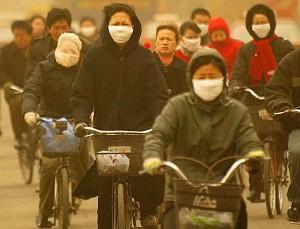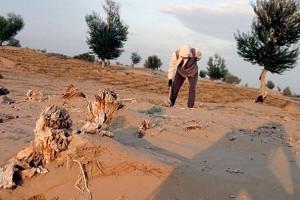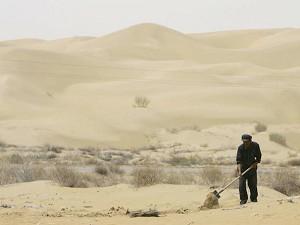Beijing will hold the 2008 summer Olympics, for which Beijing has come up with the slogan, the “green” Olympics. The “green” Olympics is China’s attempt to achieve an environmentally friendly Olympics by trying to improve environmental protection and reduce its increasing pollution. However, the severity of desertification and sandstorms is increasing in China, and may pose a challenge to the “green” vision.
Beijing’s Xiao Kang magazine reported that coinciding with the opening of China’s sixth Annual Environmental Protection Conference on April 17, 2006, was the most severe sandstorm in the history of communist China. In one night, 300,000 tons of sand dropped on Beijing and shocked even sandstorm-hardened Beijing residents. CCP number 2, Wen Jiabao, who joined the Environmental Protection Conference, expressed his concern at the severity of the sandstorm.
On this issue, He Ping, president of the International Fund for China’s Environment (IFCE), said, “This is a signal that the environment is at breaking point after over 20 years of high speed economic development. The situation has steadily grown to this point and must now be managed.”

Overgrazing, Excessive Water Use, Bad Resource Management Add to Desertification
Zheng Yi, author of Old Well and Scarlet Memorial, continually follows news of China’s environmental protection problems. In regard to Beijing’s sandstorms, Zheng Yi believes the increasing problem to be mostly caused by humankind. He said, “Actually, sandstorms in Northwest China are already a very serious issue. It is not only a regional thing, as their severity has increased in line with the destruction of China’s grassland and forests. It is basically a type of human-made disaster, not a natural disaster. There is no doubt that it is partly a natural disaster for there is relatively frequent dusty and windy weather in Northwest China. I think there is some contribution by the natural environment, but the majority is manmade.”
Beijing’s First Financial Daily said that experts at the Chinese Academy of Science recently said that destructive land use, over grazing and excess use of water all have increased desertification. In next 10 to 20 years, the frequency, intensity and dangers of sandstorms in most parts of China will likely increase.

On the desertification issue, Zheng Yi believes that the main cause is inappropriate proprietorship of the land. He thinks the desertification of grasslands would be reduced if the grasslands had specific owners. Zheng Yi explains, “If the land had specific property rights, owners would normally not allow their own grassland to deteriorate to this point. For example, some areas are rented by others for opening up wasteland and planting. These areas have produced a harvest in the first two years, but malpractice results in the same land turning into a desert in few years. Those people using the land only want to reap a quick profit and then run away. This is destructive exploitation.”
Funds for Dams, Not Environmental Protection
Zheng Yi concluded that the reason why there have been no positive outcomes to China’s efforts at environmental protection, was that there is too little funding targeted at the environment. He said, “For example, building a dam can cost tens of billions of yuan. If the money were instead used to plant trees and forests, the benefits would be far greater than building a dam. Most people, however, are unwilling to do that.”

Yi continued, “Simply speaking, it is easier to make illegal money from corruption through a big capital project rather than a forest planting exercise, so directing funds to useful environmental projects is very tough. As everyone is looking for a fast buck, the environment will continue to suffer. It all has to do with perceived benefits.”
According to First Financial Daily, the area of existing deserts, including the Gobi desert and desertification, is about 1.65 million square kilometers, of which modern desertification induced by human activities account for about 370,000 square kilometers.
(Transcribed and reorganized from Sound of Hope recording)




Friends Read Free